|
Goals:
The
purpose of the visit was to introduce a singly housed chimpanzee
in the Mysore Zoo to another chimpanzee and to reorganize basic
husbandry routine and start an enrichment plan for all species in
both zoos.
Mysore
Zoo
March
24-29, 2013
Chimpanzees
(Pan troglodytes ?) Subspecies unknown.
Suggestions: Subspecies needs to be determined by DNA
testing.
-
Wali –solitary male, alone for 49 years due to
previous aggression towards chimpanzees introduced to him.
-
Guru male, 21 years old, hairless together with Ganga
female, 52 years old
-
Mason male, 20 years old together with Mirella
female, 23 years old
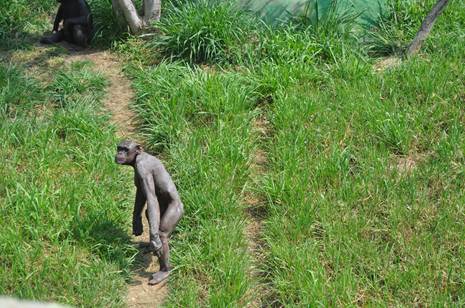
Guru,
world famous hairless chimpanzee at Mysore Zoo
Guru
along with Ganga was transferred from Chennai Zoo to Mysore Zoo on
11/08/2003 to improve their welfare by gaining a more appropriate,
open enclosure. It was reported that at that time Guru was a
“hairless mutant, confiscated from the circus for
rehabilitation”.
Although
Guru was kept with another chimpanzee, the exhibit was fenced off
of public view due to negative perception.
Suggestions: Public education with signs and volunteers
explaining Guru’s situation could change public view. Example of
Moza’s (chimpanzee) situation in Giza Zoo, Egypt was brought up
as an example. Moza was kept away from humans for years due to
having a large lump on her neck and the intolerance of the
Egyptian people of sicknesses and deformation. Once a sign was
made and her situation explained, the same people who shunned her
now embraced her situation and accepted her. Contact information
of Chimpanzee SSP and studbook keeper was also provided.
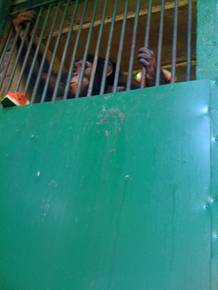
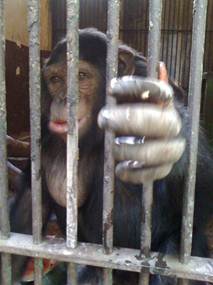
Moza
hidden from public eye due to her large lump in Giza Zoo, Egypt
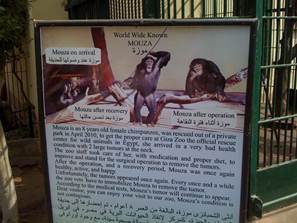 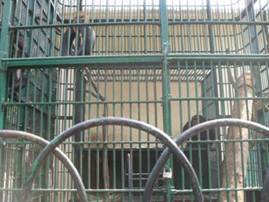
Moza’s
sign explaining her sickness
Mosa is now exhibited together with Kuku outside
Chimpanzee
exhibits
The
two chimpanzee exhibits were very satisfactory. They were large,
spacious, with plenty of trees, shades, natural soil, grass and
climbing structures.
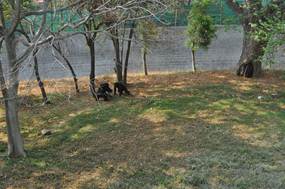 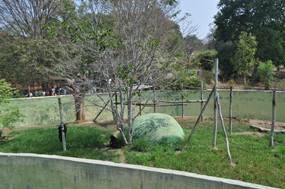
The
night houses were also large, laid out in a half circle, all
connected, excellent for introductions. They were made of concrete
bars had wooden benches and lacked substrates. Furniture was built
from wooden materials (as opposed to metal) as it should be in
high temperature countries.
Suggestion: To further improve quality, some flexible furniture
needs to be installed in each night quarters. Animals need both
structures in order to exhibit proper motor skills.
All off
exhibit areas should utilize three dimensions by adding large tree
trunks, ropes, fire hoses, hammocks, wooden shelves, etc., to
increase space and to the animals’ opportunities for exercise,
exploration and manipulation. All
cages are to be filled with substrate, browse, logs and branches.
Also, since paper is readily available in India, all animals
should receive newspapers, phone books, paper bags, etc., in the
night houses for nest building.
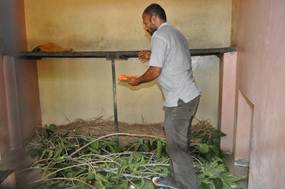 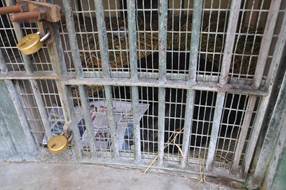
Browse,
hay, newspaper and scattered chopped diet was added to night house
cages
Introduction
1st
introduction.
After
careful consideration, it was decided that Ganga would be
separated from Guru and introduced to Wali instead. Since both
Wali and Ganga are quite elderly, they are a better match for each
other, while young Guru could join the other pair.
The introduction was successful and the two of them are
living together in harmony ever since.
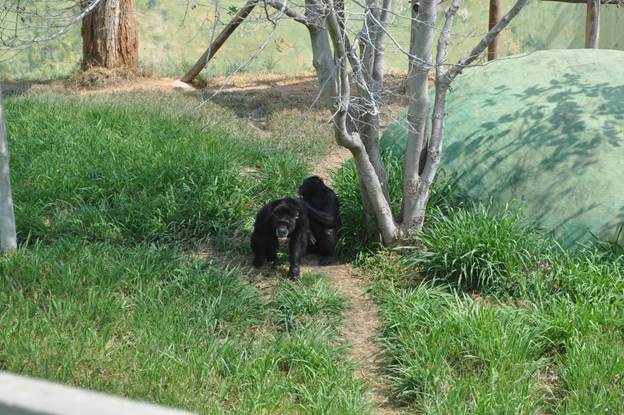
Wali
and Ganga together
2nd
introduction.
Once
the first group of chimpanzees was together, Guru was introduced
to Mirella and Mason. The introduction was successful.
However, about a week after I was gone they had gotten into a
fight, the pair chased Guru off and he received several bites. The
introduction is continuing and I remain in contact with staff. Mr.
Ravi and I email each other several times a week to keep updated
on the ongoing introduction.
Suggestions: At the moment, Mirella should be together with each
male for half a day to build better relationship with Guru. This
way no one can outnumber Guru and no chimpanzees are alone more
than half a day at the time. The chimpanzees that are paired up
will be kept inside, while the solitary animal stays on exhibit in
order to ease its loneliness. Once Guru and Mirella are closer
friends, the 3 animals should be introduced together for short
period of times (depending on their behaviors) while time is
gradually increased.
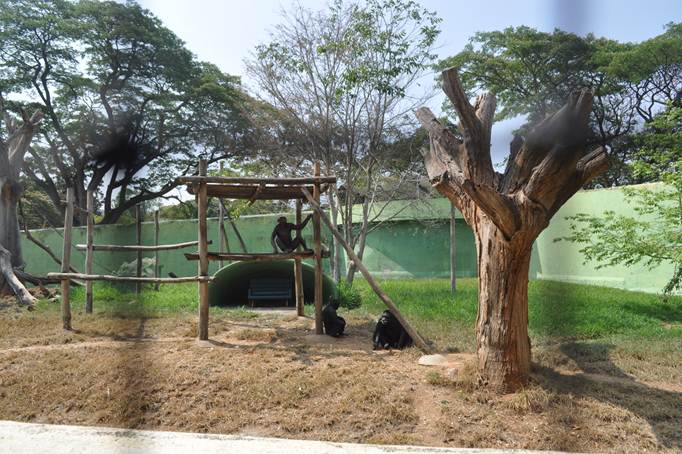
New
Delhi Zoo March
30 through April 6, 2013
Chimpanzees
(Pan troglodytes ?) Subspecies unknown.
Mani
- male, 9 years old
Rita
- female, 50 years old.
Suggestions: Subspecies needs to be determined by DNA testing.
The
New Delhi Zoo had one of the best chimpanzee exhibits I have ever
seen in my life. The exhibit was full of natural, dense vegetation
under tall, climbable trees as well as a large, approximately 600
year old ruin of Chatri that the chimpanzees can climb and find
shelter in besides their night houses.
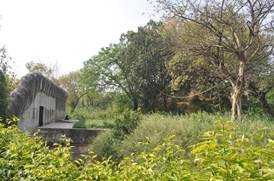 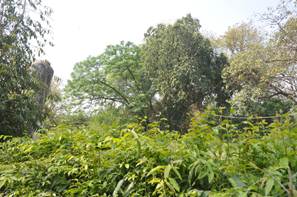
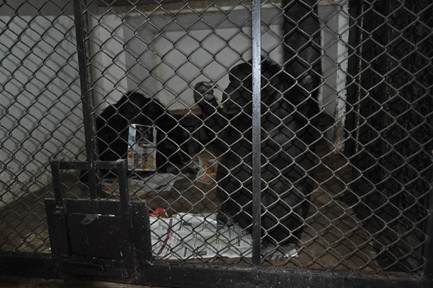
The
chimpanzees were in good health, but on the chubby side. Although
diet seemed to be appropriate (the only thing missing was cooked
meat products), the animals were a bit overweight.
Suggestions: Cooked beef (or other available meat products that
chimpanzees had a taste for) could be added to the diet as well as
starting the contra freeloading program to make the animals forage
longer and exercise while foraging.
The
night houses were large and all connected. They were made of
concrete bars, with wooden benches but lacked substrates.
Furniture was built from wooden materials (as opposed to metal) as
it should be in high temperature countries.
Suggestion: To further improve quality, some flexible furniture
needs to be installed in each night quarters. Animals need both
structures in order to exhibit proper motor skills.
All
off exhibit areas should utilize three dimensions by adding large
tree trunks, ropes, fire hoses, hammocks, wooden shelves, etc., to
increase space and to provide the animals opportunities for
exercise, exploration and manipulation. All enclosures should be
filled with substrate, browse, logs and branches. Also, since
paper is readily available in India, all animals should receive
newspapers, phone books, paper bags, etc., in the night houses for
nest building.
Since
the zoo truly has a good exhibit with sufficient night houses and
the director expressed the need of additional chimpanzees, contact
information for Chimpanzee SSP and studbook keeper was provided.
Suggestions: Considering the large number of chimpanzees that are
being confiscated from poachers in other countries the many
chimpanzees that are kept in solitary confinement and the fact
that there is potential funding available for transportation in
both zoos these zoos would be excellent candidates for rescuing
chimpanzees from other facilities to function as sanctuaries
promoting animal welfare and conservation. I found the staff
dedicated and caring and I believe the animals would be well cared
for.
General
propositions:
Besides chimpanzees, there were two additional areas that
needed extra attention in both zoos (more than general zoo
improvements); elephants and birds.
Elephants
Mysore Zoo
In my opinion, the Mysore Zoo has one the most
beautiful Asian elephant heard in captivity, including a
young bull kept among the females at all times.
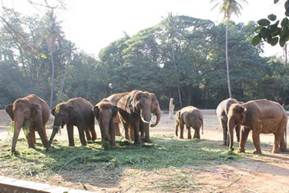 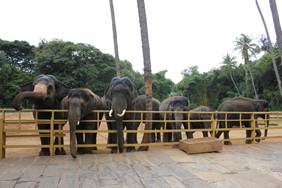
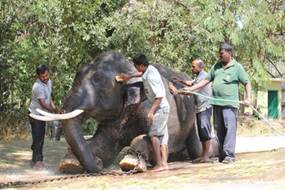 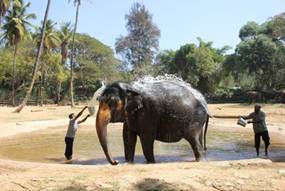
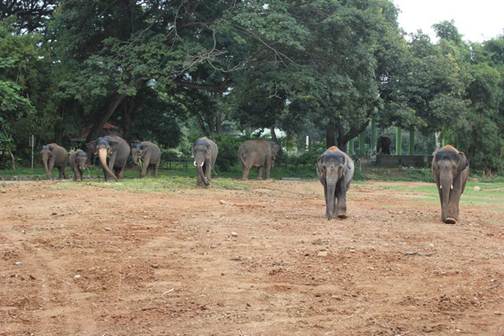
The
animals seem to be in really good health with a very devoted
staff. Also, with the exception of the young bull, all females are
now roaming around free at night as well. The bull is only
semi-restrained, being kept on an extremely long chain that
enables him to walk around the exhibit with the herd at all times.
The zoo also has 2.0 African elephants (father and son).
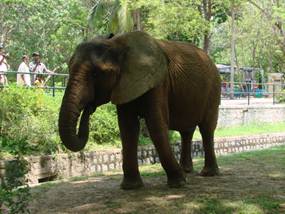 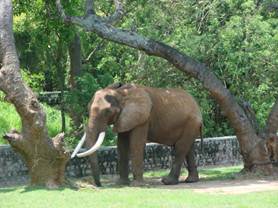
New Delhi Zoo
The
Delhi Zoo also has a very large and natural looking exhibit
housing 1.1 Asian elephants and an African bull as well. Ongoing
debate on whether isolating the African male into the empty
African elephant exhibit would be less or more detrimental to him.
The zoo is planning to get a female elephant, but it is taking
longer than the director was hoping for.
Although
the exhibit was large with natural soil and vegetation, it was
monotone regarding landscape and lacked some of the necessary
furniture and enrichment as well as substrate in the night
quarters.
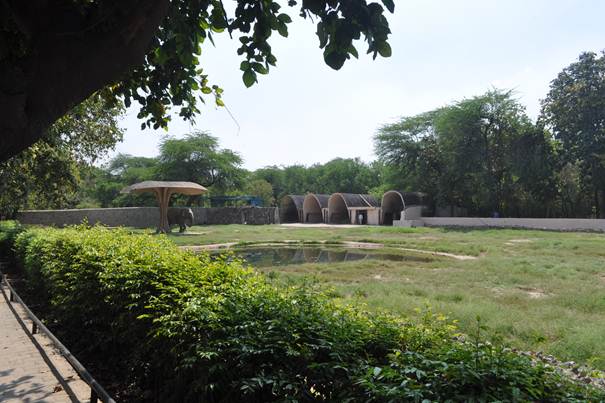
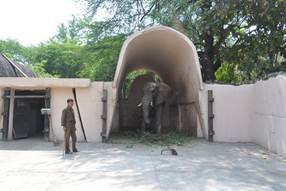 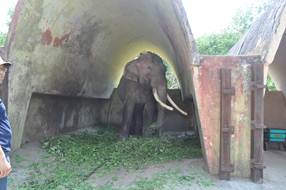
Suggestions: Substrate presentation was given in .
Contact information of Phoenix Zoos’ Elephant Manager was
provided for further consultation.
Birds
In
both zoos most birds were kept in large, natural looking exhibits;
however some bird enclosures lacked sufficient furniture,
especially those off exhibit and the quarantine/hospital areas. On
those occasions, perches were only one dimensional and usually too
big. When the perch size is too large under a bird’s feet, the
ligaments can elongate, the joints can be ruined and the birds can
get bumble feet.
Suggestions: Live trees or large, freshtree branches that provide
a variety of different diameter perches should be provided.
Night houses, off exhibit areas and correct substrate use
All
around in both zoos the animals lived in luxurious, large, green
exhibits full of plants, shades and furniture and in proper social
groups. Our focus was mostly on improving the “off exhibit”
areas where animals were isolated due to medical or husbandry
reasons or locked inside for longer periods of time for any
temporary housing reasons. Special attention needs to be paid to
all the night houses as well, where animals spend an average 14-17
hours in concrete/bar cages.
Continuing
to keep animals off of hard or cold, wet or dry, unyielding
surfaces (concrete, tile, wood floor, etc.) would be desirable.
The use of appropriate substrate (inside- paper products, hay or
straw, etc.; outside- nonflammable materials such as sand, soil,
mulch, fresh browse, etc.) will make a significant difference not
only in the animals’ health but also in improvement of the
exhibit aesthetics.
Browse
The
zoo has large amount of edible vegetation available on grounds
that could provide fresh, leafy branches (browse) at least every
2-3 days, but if possible, every day. As mentioned during the
presentation, the zoo can start planting edible trees,
bushes and even crops inside and outside of exhibits, along
visitor pathways and resting areas that will provide future
browsing materials for growing collection demands. Whether cut by
staff or available by natural damage, fallen vegetation can be
used rather than wasted.
Extending
foraging time
All
animals (especially in small, unnatural environments) need to be
fed in a way that their foraging time is extended and proper
species-specific behaviors are encouraged. If no one can be
appointed for this position, staff can be scheduled to cut browse
and chop diet on a rotation basis.
Appropriate social housing
All
animals that are social by nature should be paired up with their
conspecifics. Special attention
needs to be paid to social housing of great apes and other
primates. Please see attached document regarding laws and
regulations for social housing of primates. The Director has been
trying to get at least one additional animal for quite some time
now. Contact information for Gorilla
SSP and studbook keeper was given to start communication regarding
getting a female gorilla for the single housed male.
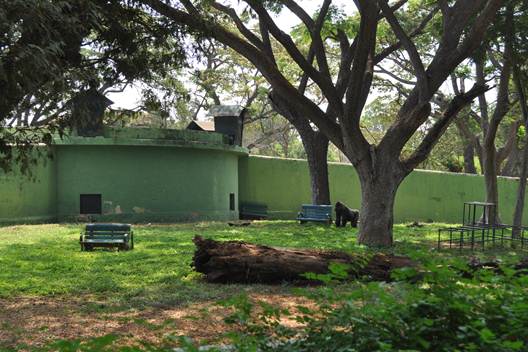
Education
The
following power point presentations were given to all staff:
·
Lack
of substrate use in zoos addresses
the easy fix of empty cages and shows how much benefit there is in
the animals’ lives when provided with substrate; i.e., when they
do not have to sit inside of empty concrete cages. This is
probably the most important animal welfare presentation to give
out of the five.
·
Contra
freeloading at the Phoenix Zoo
presentation talks about making animals work for their food in
similar ways as they would in the wild instead of eating diet in
short period of time from metal dishes or rubber tubs.
·
The
beneficial browse gives
guidelines regarding how to develop a zoo-wide browse program with
numerous browse gardens in the middle of the Sonoran Desert with
no money; it also addresses the major changes that fresh, leafy
greens can make in the animals’ lives.
·
Let
them be elephants
addresses the changes we made in our elephants’ lives, how we
helped their behaviors by teaching them how to forage right and
behave like normal females; it also talks about basic husbandry,
enrichment ideas and health care.
·
Rita
chimpanzee, a successful enrichment program at the Doha Zoo, Qatar
talks
about Rita, who was kept in solitary confinement in an empty cage
all her life, but, later introduced to her new enrichment program
as well as to a pair of chimpanzees; she now lives “happily”
in a small group setting.
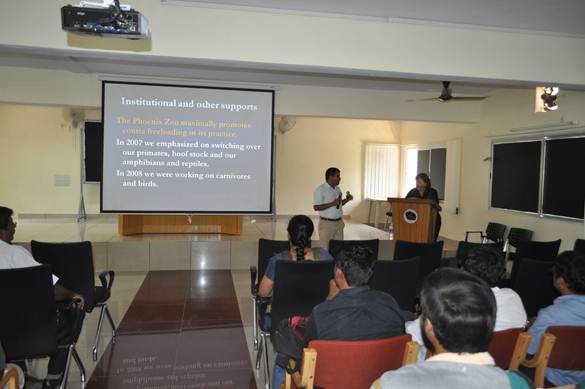
Presentations
are available at
htresz@thephxzoo.com
Renowned
Primatologist to study chimps at Mysore Zoo
article by Deccan
Herold
I
would like to thank the Mysore and New Delhi Zoos’ directors and
staffs as well as the Central Zoo Authority for their incredible
hospitality, making me feel so welcomed.
Hilda
Tresz receiving an Award of Honor from New Delhi Zoo Management
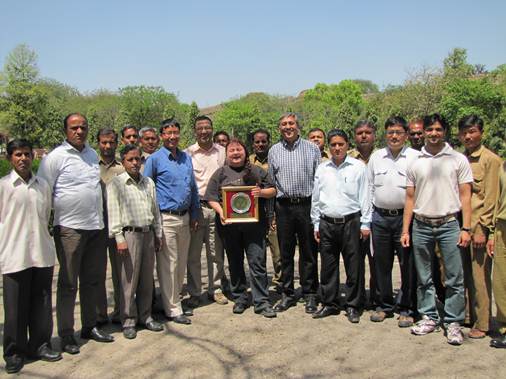
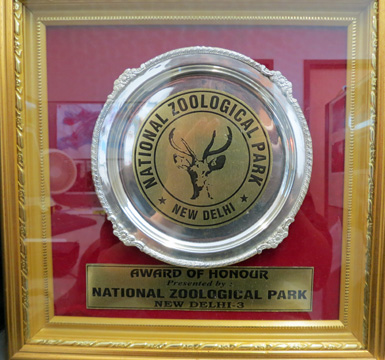
|
|





























